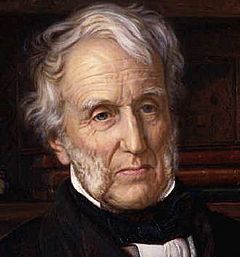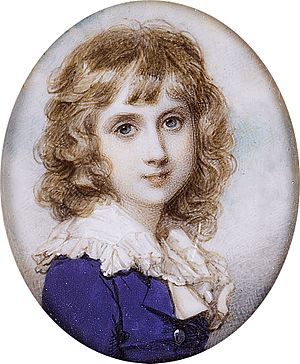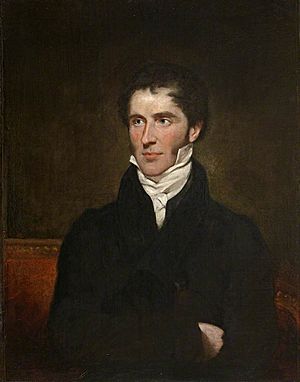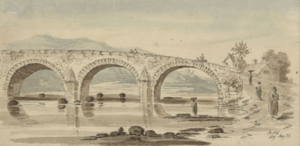Stephen Lushington (judge) facts for kids
Quick facts for kids
Stephen Lushington
|
|
|---|---|

1862 portrait (detail) by William Holman Hunt
|
|
| Born | 14 January 1782 South Hill Park, Berkshire
|
| Died | 19 January 1873 (aged 91) Ockham Park, Surrey
|
| Resting place | Ockham, Surrey |
| Nationality | English |
| Education | Christ Church, Oxford, Inner Temple |
| Occupation | judge |
| Known for | Slavery abolitionist |
Stephen Lushington, also known as Dr Lushington (born January 14, 1782 – died January 19, 1873), was an important British judge and politician. He was a strong supporter of ending slavery and stopping the death penalty. He worked as a judge in the High Court of Admiralty for many years, from 1838 to 1867.
Contents
Early Life and School

Stephen Lushington was the second son of Sir Stephen Lushington, 1st Baronet. His father was also a politician and led the British East India Company. Stephen went to Eton College and then to Christ Church, Oxford when he was 15. Later, he became a fellow at All Souls.
He also played first-class cricket a few times in 1799. He was mostly connected with the Surrey team.
His Time in Politics
In 1806, Lushington became a Member of Parliament (MP) for Great Yarmouth. He was part of the Whig group. In February 1807, he spoke in Parliament to support a law to end the slave trade.
He was re-elected in 1808. However, he lost the support of his political backer, Harbord Harbord, 1st Baron Suffield. Lushington also supported Catholic emancipation, which meant giving Catholics more rights. This was not a popular idea at the time. He soon left his seat in Parliament.
Lushington returned to Parliament in 1820 as an MP for Ilchester. He also represented other areas later, like Tower Hamlets.
As a radical politician, Lushington wanted many changes. He pushed for South American countries to be independent from Spain in 1820. He also spoke in favor of giving Jewish people more rights. In 1840, he suggested ending the death penalty. He later served on a special group in 1864 that looked into this issue. He also supported making Parliament fairer, like having elections every three years.
In 1841, Lushington left Parliament. This was because of a new law about his job as a judge.
His Career in Law
Lushington started studying law in 1801. He became a lawyer in 1806. After leaving Parliament for a short time, he focused on his legal work. In 1808, he earned a special law degree and joined a group of top lawyers called Doctors' Commons.
The Byron Case
In 1816, Lushington became a legal advisor to Lady Byron. This was after she separated from her husband, the famous poet Lord Byron. Lady Byron's mother asked Lushington for help. He helped Lady Byron with her separation and property agreements.
Trial of Queen Caroline
In 1820, Lushington was one of the lawyers who defended Queen Caroline. She was on trial before the House of Lords. He gave important advice as an expert in civil law. He also helped summarize the Queen's defense.
Becoming a Judge
In 1828, he became a judge for the Consistory Court of London. In 1838, he became a Privy Counsellor. He also became a judge of the High Court of Admiralty. He held this important judge position until 1867.
Lushington was also the Dean of Arches from 1858 to 1867. He retired from all his jobs in 1867 because of poor health.
The Gorham Judgement
Lushington was very involved in a famous legal case called the Gorham case. This case was about a disagreement between a priest, George Cornelius Gorham, and his bishop, Henry Phillpotts. The case went to the highest court, the Judicial Committee of the Privy Council.
Lushington was the only judge on the committee with the right legal experience. He helped decide the case. The court overturned an earlier decision and ruled in favor of Gorham. This decision was important for the Church of England.
Fighting to End Slavery

Stephen Lushington spent his life fighting against slavery. He dedicated a lot of his time to this cause. He had a big impact on the movement to end slavery in Britain. Some of his own family members had connections to slave ownership in the past.
When he returned to Parliament in 1821, Lushington supported William Wilberforce. Wilberforce wanted the government to pressure countries that still allowed the slave trade. Lushington helped pass a new law, the Slave Trade Act 1824. This law made slave trading a crime like piracy. It also stopped the trading of slaves between British colonies. Around this time, he worked closely with another important abolitionist, Thomas Foxwell Buxton.
In 1824–1825, Lushington supported Louis Celeste Lecesne. Lecesne and John Escoffery were free people of color who were forced to leave Jamaica. Lushington argued in Parliament that they were treated unfairly because of their skin color.
Lushington and Fowell Buxton also worked together on a special fund. This fund came from a gift by Jane Mico that had been unused for 200 years. They believed the money could be used to educate freed slaves in the colonies. They helped set up new trustees for the fund and got government money to add to it. Today, Mico University College in Jamaica still exists because of this gift. Lushington is even one of the house names there.
Lushington was also a leader of the Aborigines' Protection Society. This group worked to protect the rights of native peoples. He also helped Ellen and William Craft, who were formerly enslaved people, get an education in the 1850s.
Later Years
In his later life, Lushington lived at Ockham Park. This estate belonged to Ada Lovelace and her husband. Lushington leased the property around 1846. Some of his family had already been living there since his wife passed away in 1837.
Many famous people visited Lushington at Ockham Park. These included the artist Edward Lear and the writer Elizabeth Gaskell. The American abolitionist Charles Sumner also visited him there in 1857. Sumner once said that Lushington was "one of the ablest men in England."
Stephen Lushington passed away at Ockham Park on January 19, 1873. There is a special plaque in his memory at All Saints Church in Ockham.
His Family
In 1821, Lushington married Sarah Grace Carr (1794–1837). Sarah's mother was a good friend of the writer Anna Laetitia Barbauld. Stephen and Sarah had ten children together, five daughters and five sons.
Their sons included:
- Edward Harbord Lushington (1822–1904)
- William Bryan Lushington (born 1824), who was also a lawyer.
- Stephen Lushington (1830–1860), who died in India.
- The twins Vernon Lushington (1832–1912) and Godfrey Lushington (1832–1907). After their mother Sarah died in 1837, one of Sarah's sisters helped raise them at Ockham Park.
One of their daughters, Edith Grace, married John Pilkington Norris in 1858.
Images for kids
-
Stephen, 1789 (Richard Cosway)
-
As "Dr. Lushington", Stephen Lushington's name appears on the Buxton Memorial Fountain marking the abolition of slavery in the British Empire







